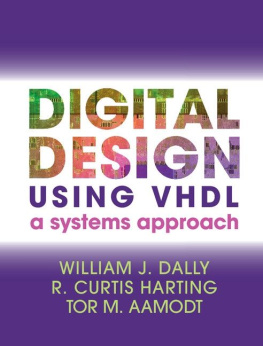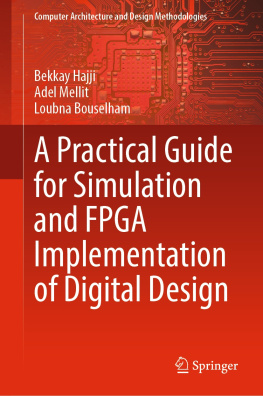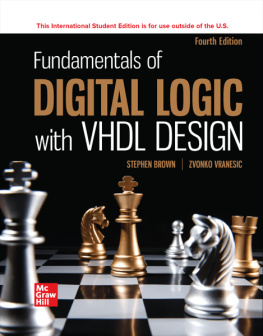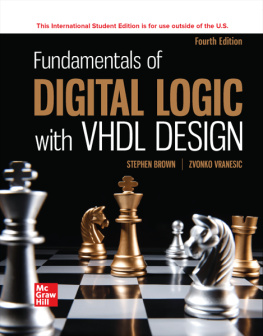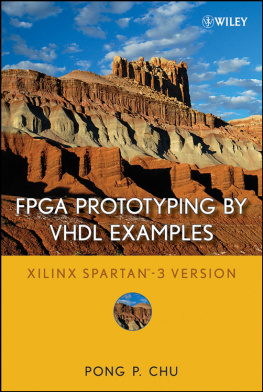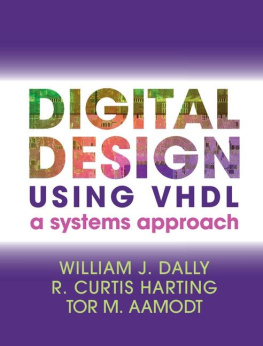William J. Dally - Digital Design Using VHDL
Here you can read online William J. Dally - Digital Design Using VHDL full text of the book (entire story) in english for free. Download pdf and epub, get meaning, cover and reviews about this ebook. year: 2016, publisher: Cambridge University Press, genre: Computer. Description of the work, (preface) as well as reviews are available. Best literature library LitArk.com created for fans of good reading and offers a wide selection of genres:
Romance novel
Science fiction
Adventure
Detective
Science
History
Home and family
Prose
Art
Politics
Computer
Non-fiction
Religion
Business
Children
Humor
Choose a favorite category and find really read worthwhile books. Enjoy immersion in the world of imagination, feel the emotions of the characters or learn something new for yourself, make an fascinating discovery.
- Book:Digital Design Using VHDL
- Author:
- Publisher:Cambridge University Press
- Genre:
- Year:2016
- Rating:5 / 5
- Favourites:Add to favourites
- Your mark:
- 100
- 1
- 2
- 3
- 4
- 5
Digital Design Using VHDL: summary, description and annotation
We offer to read an annotation, description, summary or preface (depends on what the author of the book "Digital Design Using VHDL" wrote himself). If you haven't found the necessary information about the book — write in the comments, we will try to find it.
Digital Design Using VHDL — read online for free the complete book (whole text) full work
Below is the text of the book, divided by pages. System saving the place of the last page read, allows you to conveniently read the book "Digital Design Using VHDL" online for free, without having to search again every time where you left off. Put a bookmark, and you can go to the page where you finished reading at any time.
Font size:
Interval:
Bookmark:
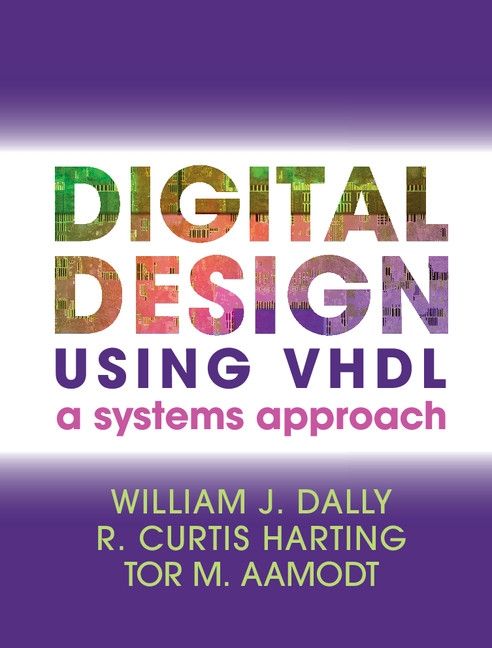
A Systems Approach
This introductory textbook provides students with a system-level perspective and the tools they need to understand, analyze, and design digital systems. It goes beyond the design of simple combinational and sequential modules to show how such modules are used to build complete systems.
- All the essential topics needed to understand modern design practice are covered, including:
- Design and analysis of combinational and sequential modules
- Composition of combinational and sequential modules
- Data and control partitioning
- Factoring and composition of finite-state machines
- Interface specification
- System timing
- Synchronization
- Teaches how to write VHDL-2008 HDL in a productive and maintainable style that enables CAD tools to do much of the tedious work.
- Covers the fundamentals of logic design, describing an efficient method to design combinational logic and state machines both manually and using modern CAD tools.
A complete introduction to digital design is given through clear explanations, extensive examples, and online VHDL files. The teaching package is completed with lecture slides, labs, and a solutions manual for instructors (available via www.cambridge.org/dallyvhdl). Assuming no previous digital knowledge, this textbook is ideal for undergraduate digital design courses that will prepare students for modern digital practice.
WILLIAM J. DALLY is the Willard R. and Inez Kerr Bell Professor of Engineering at Stanford University and Chief Scientist at NVIDIA Corporation. He and his group have developed system architecture, network architecture, signaling, routing, and synchronization technology that can be found in most large parallel computers today. He is a Member of the National Academy of Engineering, a Fellow of the IEEE, a Fellow of the ACM, and a Fellow of the American Academy of Arts and Sciences. He has received numerous honors, including the ACM Eckert-Mauchly Award, the IEEE Seymour Cray Award, and the ACM Maurice Wilkes Award.
R. CURTIS HARTING is a Software Engineer at Google and holds a Ph.D. from Stanford University. He graduated with honors in 2007 from Duke University with a B.S.E., majoring in Electrical & Computer Engineering and Computer Science. He received his M.S. in 2009 from Stanford University.
TOR M. AAMODT is an Associate Professor in the Department of Electrical and Computer Engineering at the University of British Columbia. Alongside his graduate students, he developed the GPGPU-Sim simulator. Three of his papers related to the architecture of general purpose GPUs have been selected as Top Picks by IEEE Micro Magazine and one as a Research Highlight by Communications of the ACM magazine. He was a Visiting Associate Professor in the Computer Science Department at Stanford University during his 20122013 sabbatical, and from 2004 to 2006 he worked at NVIDIA on the memory system architecture (framebuffer) of the GeForce 8 Series GPU.
Dally and Harting blend circuit and architecture design in a clear and constructive manner on the basis of their exceptional experience in digital design.
Students will discover a modern and effective way to understand the fundamental underpinning of digital design, by being exposed to the different abstraction levels and views of computing systems.
Giovanni De Micheli, EPFL Switzerland
Bill and Curt have combined decades of academic and industry experience to produce a textbook that teaches digital system design from a very practical perspective without sacrificing the theoretical understanding needed to train tomorrows engineers. Their approach pushes students to understand not just what they are designing, but also what they are building. By presenting key advanced topics, such as synthesis, delay and logical effort, and synchronization, at the introductory level, this book is in the rare position of providing both practical advice and deep understanding. In doing so, this book will prepare students well even as technology, tools, and techniques change in the future.
David Black-Schaffer, Uppsala University
Everything you would expect from a book on digital design from Professor Dally. Decades of practical experience are distilled to provide the tools necessary to design and compose complete digital systems. A clear and well-written text that covers the basics and system-level issues equally well. An ideal starting point for the microprocessor and SoC designers of the future!
Robert Mullins, University of Cambridge and the Raspberry Pi Foundation
This textbook sets a new standard for how digital system design is taught to undergraduates. The practical approach and concrete examples provide a solid foundation for anyone who wants to understand or design modern complex digital systems.
Steve Keckler, The University of Texas at Austin
This book not only teaches how to do digital design, but more importantly shows how to do good design. It stresses the importance of modularization with clean interfaces, and the importance of producing digital artifacts that not only meet their specifications, but which can also be easily understood by others. It uses an aptly chosen set of examples and the Verilog code used to implement them.
It includes a section on the design of asynchronous logic, a topic that is likely to become increasingly important as energy consumption becomes a primary concern in digital systems.
The final appendix on Verilog coding style is particularly useful. This book will be valuable not only to students, but also to practitioners in the area. I recommend it highly.
Chuck Thacker, Microsoft
A terrific book with a terrific point-of-view of systems. Everything interesting and awful that happens in digital design happens because engineers must integrate ideas from bits to blocks, from signals to CPUs. The book does a great job of focusing on the important stuff, moving from foundations to systems, with the right amount of HDL (Verilog) focus to make everything practical and relevant.
Rob A. Rutenbar, University of Illinois at Urbana-Champaign
A Systems Approach
WILLIAM J. DALLY
Stanford University
R. CURTIS HARTING
Google, Inc.
TOR M. AAMODT
The University of British Columbia


University Printing House, Cambridge CB2 8BS, United Kingdom
Cambridge University Press is part of the University of Cambridge.
It furthers the Universitys mission by disseminating knowledge in the pursuit of education, learning and research at the highest international levels of excellence.
www.cambridge.org
Information on this title: www.cambridge.org/9781107098862
Cambridge University Press 2016
This publication is in copyright. Subject to statutory exception and to the provisions of relevant collective licensing agreements, no reproduction of any part may take place without the written permission of Cambridge University Press.
First published 2016
Printed in the United Kingdom by TJ International Ltd. Padstow Cornwall
A catalog record for this publication is available from the British Library
Next pageFont size:
Interval:
Bookmark:
Similar books «Digital Design Using VHDL»
Look at similar books to Digital Design Using VHDL. We have selected literature similar in name and meaning in the hope of providing readers with more options to find new, interesting, not yet read works.
Discussion, reviews of the book Digital Design Using VHDL and just readers' own opinions. Leave your comments, write what you think about the work, its meaning or the main characters. Specify what exactly you liked and what you didn't like, and why you think so.

